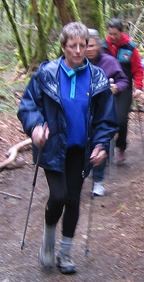 |
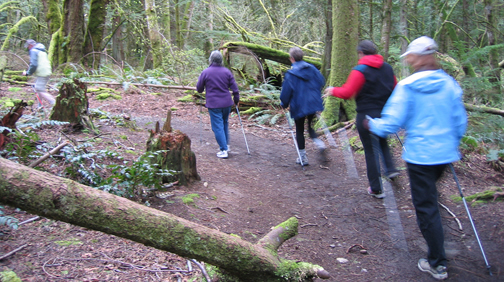 |
| Nordic walking poles seem to dance in the hands of these Nordic walkers. |
Did you know that you can take a class in Nordic walking? You can. A typical
class meets after work for a few hours once a week for a month. But wait, we
already know how to walk—we learned how when we were in diapers, one staggering
step at a time. Right? Is Nordic walking so different? Why would we want to
take
a walking class?
|
Nordic walking benefits: 1. Increased |
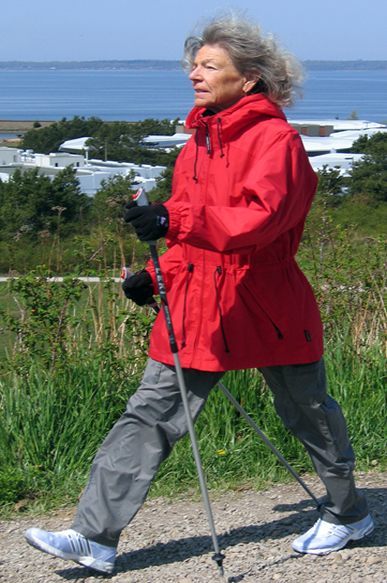 |
First, Nordic walking requires poles—Nordic walking poles—and you
use them much
as you do in cross-country skiing. A lot of your push, or propulsion, comes
from
planting your pole with each step and pushing off. For that reason, Nordic
walking for 30 minutes uses as much energy as 50 minutes of regular walking.
Second, you don't really need a class—it's pretty intuitive, and besides,
some
poles come with instructions on a DVD.
But the question remains: Why Nordic walking?
Answer: All that pole action will enable and empower you to:
Take stress off hip, knee and ankle joints
Build arm, back and torso muscles
Enhance posture
Relieve arthritis
Improve balance
And of course, lose weight because you're burning 40% more calories than
regular walking.
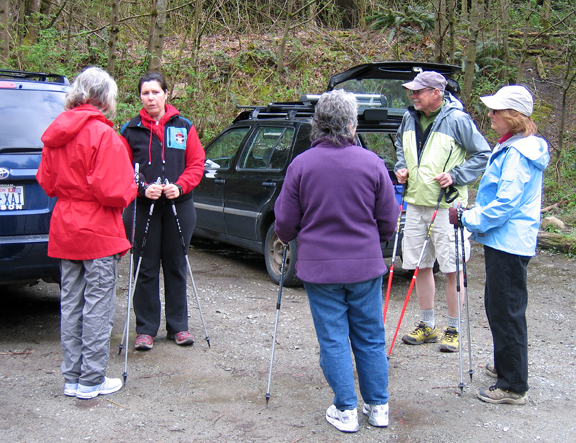 |
Besides, Nordic walking is fun. But stand by to stand for people not in the know to point and laugh. You’ll probably hear comments like “Where’s the snow?” and “Forgot your skis?” One guy gassing up his antique roadster said, "Wait, let me take your picture—now I've seen everything." Take no offense. Just smile and know that the rich and famous in La-La land have quietly taken it up in droves. |
Nordic Walking is something more than 6 million Europeans do every day. They’ve
been doing it since Nordic cross-country skiers in Norway started training
during the no-snow months to stay in condition for their winter sport. They
just
used their ski poles, but what was once an adaptation of necessity became the
mother of invention and now Nordic Walking is its own sport with its own special
gear and technique.
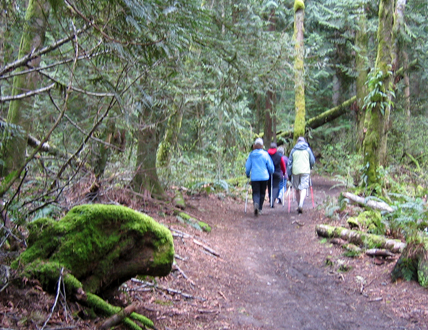 |
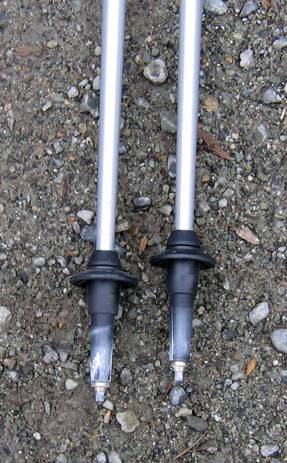 |
Nordic walking is not gear-intensive, but it’s best done with poles made for the sport. All you need is a pair of poles, which fit easily into your car or on your bike, and a place to walk. Park trails are ideal. Of course, a few friends thrown into the mix don't hurt. Just tie your shoes, choose your fleece, strap on your poles and go. |
|
.
The basic differences between ordinary walking and
Nordic walking occur as a consequence of using proper poles. These inexpensive
poles serve as extensions of the arms as they swing naturally during the walking
stride. They have adjustable straps similar to bicycle gloves that firmly attach
to the pole handles; the Leki strap is also detachable. These straps are
designed to help transfer pressure from the hip, knee and ankle joints to the
hands, arms and shoulders with every step, pole plant and push forward. Walking
pace automatically increases with these rhythmic plants and thrusts.
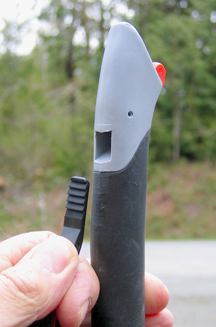 |
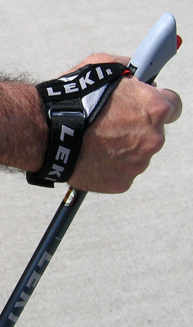 |
The releasable trigger strap, made by Leki, is much like a
bike glove without fingers that attaches by a ratchet into the pole grip.
This stabilizes the pole in your hand so that when you plant it, it stays
where you put it. Look for the L on the left glove/strap and the R on the
right so you won’t get mixed up. Either strap can go into either pole,
but the gloves, like any gloves, are for left and right hands. If you want to free your hands to rummage in your pockets, tie your shoes, buy a latte or shift clothing, just pull the red lever on top of your handle and slide the ratchet out. To reattach, just push the ratchet back in firmly until it stops clicking. |
The metal tips, good for dirt trails, gravel, sand, ice and uneven surfaces,
come with removable slanted rubber boots that prevent slippage on pavement and
other hard, flat surfaces. The poles also provide stability on any terrain in
any weather, sort of like four wheel drive. Many say it’s like having four
legs.
| Remove the rubber boots to use the metal or carbide
tips on gravel paths, dirt trails, sand, ice or snow. For added support and stability, use the removable slanted rubber booties on your tips to grip the pavement, wood or any smooth, firm surface. They stop slippage. The curved surface of the boots should always face towards the front, in the direction you’re walking, to allow you to push off more efficiently. This will greatly help your upper body workout. |
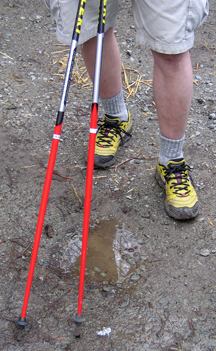 |
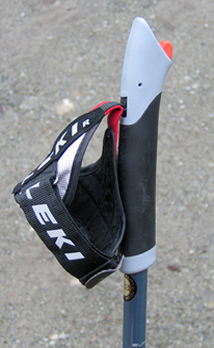 |
Most companies make both the popular aluminum and the
lighter weight carbon poles. Pros and instructors tend to use the lighter poles,
like those made by Leki, but they’re also better for older Nordic walkers
or
anyone with an injury or compromised arm strength.
It doesn’t take much to learn and get used to the swing of Nordic walking
technique. Instructions come with your poles about the specifics of adjusting
pole length, placement and general use. Or you can get social and take a class.
In the meantime, here are some simple tips:
Hold your poles with a loose grip. No white knuckles! Push-off pressure is
on the sides of your hands.As you’re standing still with your pole tips
on the ground, your arm -
elbow to hand – should form a right angle. Keep your arms and shoulders
relaxed, elbows close to your body.
As you walk, keep your chin up and look out at the horizon.
Keep your arms as straight as possible and swing them from the shoulder,
not the elbow. Always plant the right pole forward when the left foot leads
and vice
versa.
The poles should not plant out in front of you but be even with the heel
plant of the opposite foot.With pressure on the side of your hand in the strap,
push each pole back
f irmly as far as possible as you swing through your motions forward.
Release your grip on the handle at the end of each swing.
Bring the pole forward and start the motion again.
Walk normally but use the straps and poles to push yourself forward.
Keep a constant speed.
| One of the best places to Nordic walk is your local trail. Once you get the hang of Nordic walking, your pace increases, the rhythm takes over and you feel like you could walk forever. |
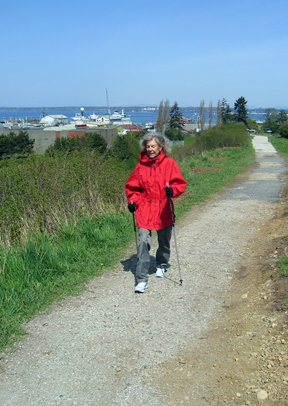 |
Perceived exertion is much less than actual exertion in Nordic walking. You
won't feel that the upper body workout adds 40 percent effort and calorie
expenditure to your walk. That's true of distance and time too—it just
feels
easy—so try not to do too much in your first outings. Consistency is more
important than intensity so do a little more each time. Thirty minutes of Nordic
walking is equivalent to 50 minutes of walking without poles.
This simple, low-impact sport is good for all ages and fitness levels. Although
traditionally used by athletes, anyone can do it. Those with Parkinson’s,
MS,
neuropathy and any balancing issues can also benefit, as can anyone with knee,
hip and posture problems.
Nordic walking is at home in the city or in the country, on the beach or in
the
mountains. And since you can get poles that telescope, they can be packed for
travel anywhere.
Although the techniques are fairly universal, Nordic walking poles are made
by
many companies. For more information, visit your local sporting goods outlet,
check www.leki.com and/or Google Nordic walking.
 |
|
| In Nordic walking, there is no finish line. But when you do finish your walk, you’ll feel like you’re taking home a lot more than a blue ribbon. |